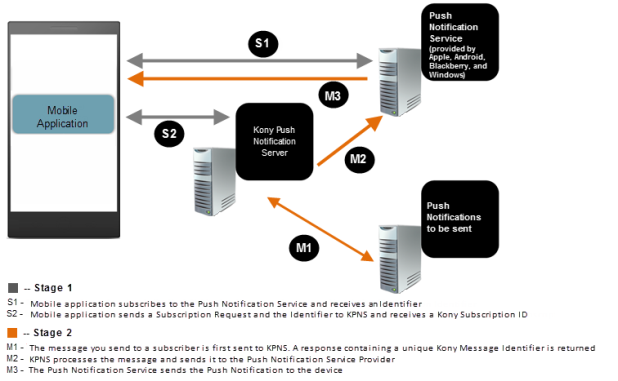Introduction
The Kony Fabric Engagement Services allows you to send push messages, email , SMS and passes to subscribed users through campaigns and events. The system uses ksid or ufid or deveiceId to send event notifications to the subscribed users.
Advantages of Using Kony Fabric Engagement Services
The advantages of using Kony Fabric Engagement Services include:
- Ease of use: You can use a single interface to send push notifications to numerous devices running on various platforms. You can also choose to send push notifications to custom IDs instead of identifiers received from the push notification service providers.
- No platform specific formatting: Kony Fabric Engagement Services allows you to leverage all the features available on individual platforms (features available on iPhone, Android, BlackBerry, and Windows) without any platform specific formatting requirements.
- Reliable: Automatically performs a specified number of retries on push failure.
- Extensible: Kony Fabric Engagement Services supports all the platforms that support Push Notifications (Apple, BlackBerry, Android and Windows). Provision is made to support any new feature with a negligible upgrade impact.
- Scalable: Kony Fabric Engagement Services supports clustering to handle a large number of requests.
- Robust: Kony Fabric Engagement Services performs multiple levels of validations and reduces the resource utilization for invalid or improper requests.
- Ease of integration: Kony Fabric Engagement Services accepts requests in XML, and JSON (only for Messaging) format and thereby offers an easy integration.
- Modular: Kony Fabric Engagement Services is divided into Subscription, and Messaging and Query. These modules can be used independently and are not interdependent. This allows modular integration with ease.
How Kony Push Notifications Works
To send push notifications using KPN is a two-stage process:
- Stage 1: Subscription
- Stage 2: Messaging
Stage 1 involves the following process:
- The mobile application subscribes or registers for push notifications service with a provider. If the subscription is successful, the push notifications service provider returns a unique identifier to the mobile application.
The following is the list of platforms and corresponding push notifications service providers, and the unique identifiers they return:
| Platform | Push Notifications Service | Unique Identifier |
|---|---|---|
| Android | Android Google Cloud Messenger (GCM) | Registration ID |
| BlackBerry | BlackBerry Infrastructure | Device ID |
| Apple | Apple Push Notification Service (APNS) | DeviceToken |
| Windows Phone | Microsoft Push Notification Service (MPNS) | Unique URL |
| Windows Phone | Windows Push Notification Service (WNS) | Unique URL (windows 10 ) |
Kony Platform provides APIs that you can use to enable push notifications for an application on a device and also an API to deregister from the push notification service.
- The mobile application sends a subscription request along with the unique identifier to the Engagement Server, which in turn sends a Kony Subscription ID to the mobile application.
Stage 2 involves the following process:
- The message you send to the subscriber is first sent to the Engagement Server in a Kony specific format.
The Engagement Server immediately sends a response containing a unique Kony Message Identifier (can be used for status queries). - The Engagement Server processes the message and sends it to the push notifications service provider (Apple, BlackBerry, Android, or Windows).
- The push notification service provider, then sends the push notifications to the device.
The following image illustrates the two stages involved in Engagement Server:

| Copyright © 2015 Temenos AG. All rights reserved. |